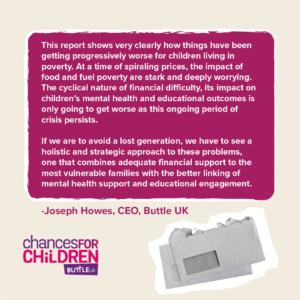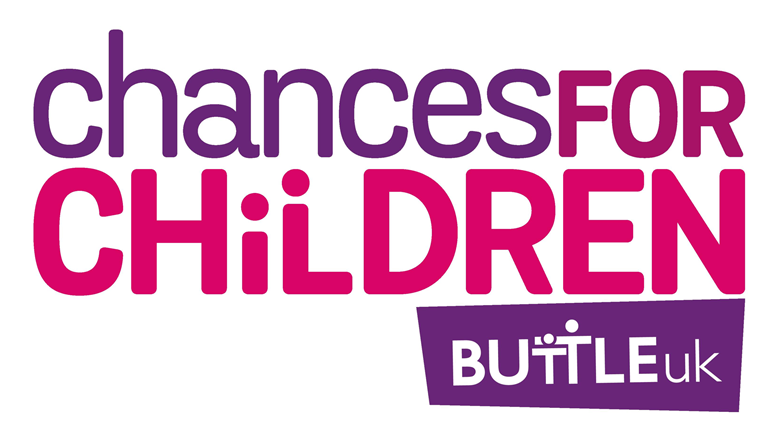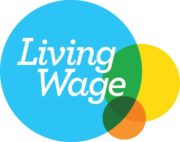State of Child Poverty 2022
As we begin to transition out of the COVID-19 pandemic, the Cost of Living Crisis is hitting the poorest families the hardest. This year, for the State of Child Poverty 2021-22, we have surveyed over 1000 frontline workers who collectively support 60,000 children and young people.
This is the fourth annual publication of our report and numbers are on the rise. As we begin to see the tail end of the COVID-19 pandemic, with very little time to recover and breathe, the country has been plunged into the Cost of Living crisis. Our last blog discussed how the poorest families are being impacted the most.
The findings from this report are stark. From desperately needing laptops and tablets to stay connected over the last couple of years, we are now seeing that families are having to choose between heating or eating.
The Cost of Living crisis is having a huge impact on children’s education and wellbeing, as the numbers for adverse childhood experiences (ACEs) are increasing, the challenges that children and young people are facing become more intense than ever. If parents and carers are unable to afford the bare essentials such as utilities, food or even beds for their children, how do we expect them to thrive in education and become their best selves?

Key Findings
- Support workers say 45% of children in their care live in destitution: a 9% year on year increase.
- Utilities and bills: 18% more families need support with utilities in the last year alone, and demand has almost doubled since 2020; support workers reported a 37% decrease in support with utility bills.
- Food: 12% uplift in the number of families struggling to afford food; food bank demand increases 9% year on year; and 83% of support workers say access to food is a barrier to education.
- Mental Health: Access to counselling, therapy and mental health support saw the biggest drop in availability despite the proportion of support workers reporting mental health problems with children increased by 5%.
With access to over 60,000 children, these support workers are at the front line of delivery. Over 1,000 support workers revealed:
- Nearly half (45 per cent) of children live in destitution, meaning they are going without the essentials needed to eat and stay warm, dry, and clean: a 9% year on year increase.
- Over half of the families they support are unable to afford to heat their homes or eat to a basic standard (55% and 57% respectively).
- Record levels of demand for their services, including an (i) 18 per cent year on year increase in demand for financial support for utility bills; (ii) 12 per cent year on year increase in demand for help finding accommodation; and (iii) 8-9 per cent year on year increase for support obtaining household items, food banks, and local authority welfare assistance.
The survey also shows the impact that the cost-of-living crisis is having on children’s schooling, and that it is comparable to the pandemic:
- Last year, 62 per cent of support workers said children they work with fell behind due to the pandemic. This year, they report that 51 per cent of children are falling behind at school because of the cost-of-living crisis.
The cost-of-living crisis has wide ranging negative impacts on children’s wellbeing. There has also been a:
- 5 percent uplift year on year in the numbers of children and young people: (i) experiencing mental health problems, including anxiety and depression [2022: 66 per cent; 2021: 61 per cent; 2020: 51 per cent] and (ii) those having behavioural problems [2022: 62 per cent; 2021: 57 per cent; 2020: 53 per cent];
- 3 per cent uplift in those experiencing parental relationship difficulties[2022: 64 per cent; 2021: 61 per cent; 2020: 51 per cent].
The biggest barriers to education were:
- mental health related, including dealing with past and ongoing adverse childhood experiences [ACEs] (93 per cent said it was either a lot or somewhat harder because of this); and access to food(83 per cent).
Considering support workers said the biggest barrier to education was dealing with past and ongoing ACEs, it is concerning that they also reported access to counselling, therapy, and mental health support as being the service which saw the single largest decrease in availability year on year.
Though 21% of support workers reported an increase in availability of therapy services, a significant 65% reported that they felt there had been either a small or large decrease, resulting in a net reduction of 44%.
Support workers also judged the most critical support needed by vulnerable families and young people going forwards:
- 29 per cent of support workers listed counselling, therapy, and other mental health support as being most critical; and
- Financial support for rent/utility bills saw the biggest year on year leap, jumping from 6 per cent in 2021 to 28 per cent in 2022.
Buttle UK also support recent calls for a dedicated Cabinet Minister for Children and Young People, so that longstanding calls for a nationwide Child Poverty Strategy can be realised. This strategy should:
- Make Mental Health Support Teams available in all schools.
- Implement a review of the state school curriculum to consider: (i) the balance between academic areas with those that have come to be called ‘enrichment’ (i.e., activities designed to build motivation or resilience; encourage exercise or learning new skills); and (ii) how social, emotional and health education can become a more meaningful part of the curriculum.
- Promote within schools an understanding of the link between Adverse Childhood Experiences and trauma and provide better access to therapeutic support and more specialist targeted support for those where this link exists.
- Encourage corporates and charities to work together to support vulnerable groups directly, similar to Buttle UK’s School Uniform Campaign with George at Asda, which saw £125,000 of pre-loaded gift cards for school uniform passed on to families who needed them.
The findings of this report are gathered from the direct experiences of those working on the frontline of health, education, housing, and social care, supporting families and young people living in poverty. Their perspectives were gathered through our fourth annual State of Child Poverty survey. This year, we had a record 1,042 respondents to the survey, who responded between the 11th July – 12th August 2022. The focus of this study has been the long-term impact of the COVID-19 pandemic as we move away from the most severe restrictions of the last two years. It has also focused on the growing cost-of-living crisis, and the relationship between the two.





